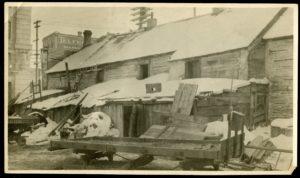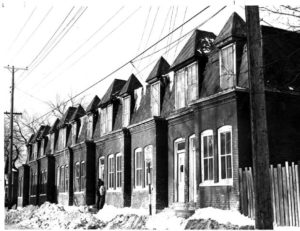
In December 1914, E.W.J. Hague, a seventeen-year veteran of Winnipeg’s health department presented a lantern slideshow to the People’s Forum, a weekly lecture series held at the corner of Jarvis and Main Street by the Methodist Church’s All People’s Mission. His topic for that evening was the “story of Winnipeg’s struggle for better housing over the last quarter of a century.”[1] Hague had been hired as one of the city’s first housing inspectors in 1897 and became chief inspector in 1922.[2] Hague’s slides on that night in 1914 included images of houses that grew by an accretion of lean-tos and sheds until they came to house upwards of twenty families. In one case, five separate ‘dwellings’ had been established on a sixty-six-foot-wide lot. The Free Press reported that his slides showed “ventilation shafts virtually sealed up both at top and bottom, shafts so narrow that no sunlight could penetrate to the windows at the bottom, and areas the usefulness of which could be offset at any time by the construction of adjacent buildings.”[3]
By the time Hague retired at the end of the 1920s, he had emerged as one of the city’s most prominent advocates of public housing. He was also the first of a series of civic officials who were outspoken in their support for the creation of public housing.[4] In a 1921 housing report, for example, Hague called on the city to build and rent housing to “persons who cannot afford to buy.”
What I have in mind is a district laid out in an attractive manner with good streets, boulevards, trees, park school site, library, picture theatre, and a few necessary stores, all built and designed as part of one harmonious plan. The houses need not be large, but the architectural features should be just as pretty as those of the Crescentwood district, in fact it would be a wage earners Crescentwood. People say, “Oh, but the working man does not want to live in a segregated Area.” On[e] does not hear the Crescentwood or Armstrong’s Point residents objecting to segregation, though they none the less are so.[5]
In what amounted to a valedictory speech in 1929 to the annual convention of the Social Services Council of Canada, Hague, was “emphatic in his advocacy of some government housing scheme” in his address. There already were “many successful schemes in various parts of the world.”[6] Hague was no one-trick pony: upon his retirement from the city in 1930, he served for four years as an Independent Labor Party member on the Winnipeg school board, where he opposed what he termed “false economies” such as firing the city’s only kindergarten teacher, cutting teachers’ wages, dropping medical and dental services for students, and charging students for textbooks.[7]
Hague was succeeded as the city’s chief housing officer by Alexander Officer, who had come to Canada after receiving training in sanitation and inspection in Scotland.[8] Like Hague, he played a national role in public-health inspection, using this position to speak forthrightly on the need for public housing, ending a 1927 speech to the Annual Convention of the Canadian Public Health Association by quoting American housing reformer, Lawrence Veiller’s 1910 Housing Reform: A Handbook for Practical Reform in American Cities. “No housing evils are necessary; none need be tolerated; where they exist they are always a reflection upon the intelligence, rightmindedness and moral tone of the community.”[9] In the same speech, he identified the key elements of any meaningful low-cost housing program: “There will always be a large number of people who cannot afford to purchase a home, and it becomes the business of somebody—civic, provincial, or federal—to see to it that a sufficient number of suitable and sanitary dwellings are available.” This would require “providing for the borrowing of money at low rates of interest, and the power to condemn old and insanitary tenements in order that large parcels of land may be acquired at reasonable prices.”[10]
In 1935 Officer told a federal housing inquiry of how a landlord would buy a large house in an older neighbourhood for “a nominal sum, gets secondhand plumbing and gas stoves of questionable value and puts them in the rooms and he puts in families.” Suites in attics that were intended as storage rooms were common: they were according to Officer unsanitary, dark, stifling hot in summer, and deadly in the case of fire. The solution, he said, lay in the federal funding of municipal housing projects.[11]
A dozen years later, in an interview with a Free Press reporter, a clearly frustrated Fred Austin, then the city’s chief housing inspector, pulled an earlier report from his desk, titled “The Crying Needs of Housing Today.” He pointed to its recommendation “That dwelling units be constructed out of adequate grants from the federal government, and, and that they pass to municipal control and be made available only to those families who need more space than they can pay for at a rental of about one fifth their salary or wages.” The need for such an initiative was, he said, greater than ever.[12]
In 1948, William Courage, the city’s director of emergency housing wrote that a public housing program was required to bring housing costs within the means of low-income earners. The private sector, he concluded, could not build enough housing units at an affordable price. He identified the large social cost associated with poor and inadequate housing, noting that the bulk of the workload of family, child care, and protection agencies came from areas with the worst housing conditions.[13]

A 1950 profile of Courage in the Tribune likened him to a physician who over the preceding five years had “dealt with 33,000 cases caused by Canada’s chief social disease, housing shortage.” Born in Scotland Courage had come to Canada in 1928, where he eventually found work in the City of Winnipeg’s welfare department. He did not go to university until 1944 when he took a degree in social work. In his role as the head of emergency housing, he had met with every one of the households that were seeking housing.[14] In 1950 Courage wrote that was necessary to demonstrate to the province the need for “immediately enacting housing legislation, so that the terms and conditions of the National Housing Act would become operative here.”[15] The following year, when there were still 362 families living in the four emergency shelters he said the only solution, lay in the development of public housing projects.[16] In a report issued at the beginning of 1953 Courage warned that the city “was faced with the chronic hard core of Winnipeg’s basic housing problems.” He noted that many of the city’s emergency shelters had “all the elements of substandard slum dwellings.” Eighty percent of the 1,427 applications for emergency housing came from households with two or more children, 50 per cent from households with more than four children. Once more, he said that the only solution lay in the development of low-income housing.[17] Courage did live to see the city, in collaboration with the provincial and federal government develop the Burrows-Keewatin and Lord Selkirk Park Projects. Tom Yauk, who was then a young city of Winnipeg employee who would go on to have play an important role in neighbourhood-based plannig, was so impressed by Courage’s compassionate and humane approach to housing that he dedicated his academic thesis on Lord Selkirk Park to the man, citing him as an inspiration.[18]
Bureaucrats are often castigated as gray, faceless, and even heartless. But in Winnipeg, a succession of visionaries held senior housing positions. While they were unable to overcome the entrenched opposition of the city’s elite to public housing, they were courageous and unapologetic in making the case for public housing.
Back to The Struggle for Public Housing in Winnipeg
[1] “Struggle for better housing,” Winnipeg Free Press, December 14, 1914; “Housing might be better here,” Winnipeg Tribune, December 14, 1914. Manitoba Historical Society, The People’s Forum, http://www.mhs.mb.ca/docs/features/timelinks/reference/db0043.shtml, accessed on May 12, 2021.
[2] “Struggle to save,” Winnipeg Morning Free Press, September 14, 1897; “Who’s who—in municipal election slate,” Winnipeg Evening Tribune, November 16, 1932.
[3] “Struggle for better housing,” Winnipeg Free Press, December 14, 1914; “Housing might be better here,” Winnipeg Tribune, December 14, 1914. Manitoba Historical Society, The People’s Forum, http://www.mhs.mb.ca/docs/features/timelinks/reference/db0043.shtml, accessed on May 12, 2021.
[4] “Health department to start housing survey,” Manitoba Free Press, January 20, 1921.
[5] Ernest W.J. Hague, “Report on housing survey of certain selected areas,” City of Winnipeg Health Department, 1921, City of Winnipeg fonds, Committee on Public Health and Welfare, Communications, Box 590 File 29, 108, 118.
[6] Winnipeg Downtown Places, 95 MacDonald Avenue – Point Douglas Presbyterian / Our Lady of Lourdes Church, http://winnipegdowntownplaces.blogspot.com/2013/03/95-macdonald-avenue-point-douglas.html, accessed July 8, 2020; “Responsibility for youth is discussed,” Manitoba Free Press, April 5, 1929.
[7] “Results at a glance,” Winnipeg Free Press, November 26, 1932; “Farmer scores Hydro contract as grave error,” Winnipeg Evening Tribune, November 24, 1932; “How the votes were transferred,” Winnipeg Free Press, November 26, 1934; “Official first count,” Winnipeg Free Press, November 30, 1936.
[8] “Congratulations,” Winnipeg Tribune, August 21, 1943; Family search, Alexander Officer, https://ancestors.familysearch.org/en/KLGK-WK1/alexander-officer-1878-1973 accessed July 7, 2021.
[9] Alexander Officer, “The Sanitary Inspectors’ Association of Canada: Housing and Public Health,” The Public Health Journal, volume 18, number 6, 1927, 290.
[10] Alexander Officer, “The Sanitary Inspectors’ Association of Canada: Housing and Public Health,” The Public Health Journal, volume 18, number 6, 1927, 284–285
[11] Parliamentary Committee on Housing, Minutes of Proceedings and Evidence of Special Committee on Housing, Ottawa: King’s Printer, 1935, 170-181, 364, quoted in John C. Bacher, “Keeping to the private market: the evolution of Canadian housing policy: 1900–1949,” Doctoral thesis, McMaster University, 1985, 138–139.
[12] “City short 10,000 housing units, yet 400 stand empty says official,” Winnipeg Free Press September 29, 1947.
[13] “Courage report urges cheap, public housing,” Winnipeg Free Press, December 22, 1948.
[14] Percy Rowe, “It’s your business,” Winnipeg Tribune, February 11, 1950.
[15] “Home shortage worse, says Courage,” Winnipeg Tribune, January 14, 1950.
[16] “High rents held forcing out poor,” Winnipeg Free Press, February 22, 1951.
[17] “Housing lack acute, city warned,” Winnipeg Free Press, January 28, 1953.
[18] Thomas B. Yauk, “Residential and Business Relocation from Urban Renewal Areas: A Case Study—The Lord Selkirk Park Experience,” Master of City Planning Thesis, University of Manitoba, 1973,
